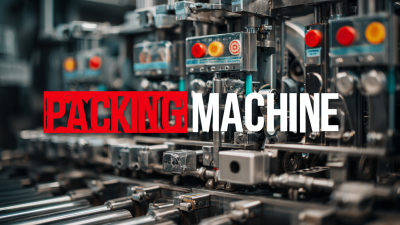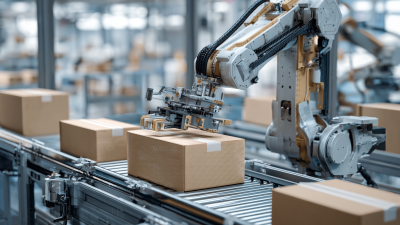Revolutionizing the Industry: How Packing Machines Enhance Efficiency and Sustainability
In today's fast-paced industrial landscape, the integration of advanced Packing Machines is pivotal in transforming operational efficiency and sustainability across various sectors. According to a recent report by MarketsandMarkets, the global packing machine market is projected to grow from USD 40.24 billion in 2023 to USD 53.53 billion by 2028, reflecting a CAGR of 5.9%. This growth signifies a strong shift towards automation and innovative technologies that minimize waste and enhance productivity.

Packing Machines not only streamline production processes but also contribute to environmental sustainability by using less packaging material and energy. As businesses strive to meet both consumer demand and regulatory standards for sustainability, these machines are becoming indispensable tools in achieving their goals. By leveraging data-driven insights and automation, companies can revolutionize their packing operations, creating a more efficient and eco-friendly future.
Enhancing Production Efficiency with Advanced Packing Machines
In today's fast-paced production landscape, advanced packing machines play a pivotal role in enhancing production efficiency. These state-of-the-art machines streamline packaging processes, significantly reducing downtime and labor costs. By automating the packing cycle, companies can achieve faster throughput while maintaining high-quality standards. Furthermore, the integration of smart technology allows for real-time monitoring and adjustments, ensuring that production lines operate at peak performance with minimal interruptions.
**Tips:** To maximize the efficiency of packing machines, focus on regular maintenance checks to prevent mechanical issues. Implementing an employee training program on the latest technology can also enhance productivity by optimizing the machine's capabilities. Additionally, analyzing packaging processes for potential bottlenecks will allow you to make necessary adjustments, ensuring a smooth workflow.
Moreover, advanced packing machines contribute to sustainability by optimizing material usage and reducing waste. Innovations such as eco-friendly packaging options and energy-efficient operations not only meet consumer demand for greener practices but also help companies lower their environmental footprint. By prioritizing both efficiency and sustainability, businesses lay the groundwork for long-term success in their respective industries.
Revolutionizing the Industry: How Packing Machines Enhance Efficiency and Sustainability
| Aspect | Description | Impact on Efficiency | Sustainability Benefits |
|---|---|---|---|
| Automation | Use of robotic systems to handle packing tasks. | Increases speed and reduces human error. | Reduces energy consumption over manual labor. |
| Smart Technology | Incorporation of IoT sensors for real-time monitoring. | Optimize performance through data analysis. | Minimizes waste by predicting maintenance needs. |
| Pack Materials | Use of recyclable and biodegradable materials. | Streamlined packing processes with less material usage. | Promotes environmental friendliness. |
| Customization | Ability to adapt packing sizes and shapes easily. | Reduces excess packaging and optimizes space. | Decreases carbon footprint through efficient logistics. |
| Integration | Seamless connectivity with other production systems. | Streamlines workflow and reduces downtimes. | Enhances resource utilization across processes. |
The Role of Automation in Modern Packaging Solutions
The integration of automation in modern packaging solutions has transformed the industry, driving significant improvements in efficiency and sustainability. According to a report by the International Society of Automation, automated packing systems can increase production speed by up to 50%, allowing companies to meet rising consumer demands while minimizing labor costs. Such advancements not only streamline operations but also reduce the risk of human error, contributing to higher product quality and reliability.
Moreover, automation plays a crucial role in enhancing sustainability within packaging processes. A 2022 study by Smithers Pira revealed that automated systems can decrease material waste by approximately 20% compared to traditional methods. By optimizing material usage and reducing excess packaging, companies can lower their environmental footprint. Furthermore, automated machines can be programmed for greater precision, which helps in using recyclable materials effectively, aligning production practices with global sustainability goals. As the industry continues evolving, embracing automation is essential for businesses looking to thrive in a competitive landscape while committing to sustainable practices.
Revolutionizing Efficiency and Sustainability in Packaging
This chart displays the efficiency improvements and sustainability metrics observed in various packaging technologies over the recent years. The data showcases the percent increase in efficiency (measured in units produced per hour) and sustainability (measured in reduced waste percentage) with the adoption of automation in packaging solutions.
Sustainable Practices in Packing Machine Design and Operation
The advancement of packing machines is at the forefront of promoting sustainable practices within the industry. Modern designs focus on reducing material usage while maintaining packaging integrity. According to a 2022 report by Smithers, about 30% of packaging waste can be avoided through optimized packing machine operations. These machines utilize cutting-edge technology to streamline the packing process, leading to a significant reduction in energy consumption and raw material usage.
Furthermore, many packing machines now incorporate eco-friendly materials and designs that facilitate recycling and reduce carbon footprints. A study by McKinsey & Company shows that the adoption of sustainable packing solutions could reduce global emissions from packaging by up to 45% by 2030. Innovations such as biodegradable packing materials and efficient machinery that minimizes waste during production are key drivers of this transformation. As industries embrace these sustainable practices, the packing machine sector plays a crucial role in the broader effort to achieve environmental goals, leading to a more responsible and efficient future in manufacturing and distribution.

Case Studies: Successful Implementation of Packing Technology
 The adoption of advanced packing technology has proven to be transformative for various sectors, as shown in multiple case studies. For instance, a leading food processing company reported a 30% reduction in packaging waste after implementing a high-efficiency packing machine that utilized biodegradable materials. According to the 2023 Global Packaging Trends report, companies integrating eco-friendly packing solutions have seen a notable increase in consumer satisfaction, with 67% of consumers expressing a preference for brands that prioritize sustainability.
The adoption of advanced packing technology has proven to be transformative for various sectors, as shown in multiple case studies. For instance, a leading food processing company reported a 30% reduction in packaging waste after implementing a high-efficiency packing machine that utilized biodegradable materials. According to the 2023 Global Packaging Trends report, companies integrating eco-friendly packing solutions have seen a notable increase in consumer satisfaction, with 67% of consumers expressing a preference for brands that prioritize sustainability.
Another case study involving a prominent e-commerce retailer highlighted the effectiveness of automated packing systems in enhancing operational efficiency. The retailer achieved a 40% decrease in packing time and a 25% reduction in shipping costs after upgrading to intelligent packing technology that optimizes box sizes based on the dimensions of the items being shipped. As reported by the Packaging Machinery Manufacturers Institute (PMMI), these innovations are not only reducing costs but also playing a vital role in meeting the growing demand for faster and more efficient delivery services in the industry.
Future Trends in Packing Machines and Their Environmental Impact
 The packing machine industry is witnessing rapid evolution, particularly between 2025 and 2031, as highlighted by recent market research. Notably, the demand for smart and automated packaging solutions is growing, driven by a focus on enhancing efficiency and sustainability. The market for advanced packing equipment is expected to reach a staggering value of approximately $2.67 billion by 2032, reflecting a significant shift towards automation and technological integration in production processes.
The packing machine industry is witnessing rapid evolution, particularly between 2025 and 2031, as highlighted by recent market research. Notably, the demand for smart and automated packaging solutions is growing, driven by a focus on enhancing efficiency and sustainability. The market for advanced packing equipment is expected to reach a staggering value of approximately $2.67 billion by 2032, reflecting a significant shift towards automation and technological integration in production processes.
In parallel to these advancements, there is a noticeable shift in consumer attitudes towards sustainable packaging. While food safety and shelf life remain critical factors influencing purchase decisions, the environmental impact of packaging has seen a decline in perceived importance among consumers. According to a Deloitte report, there is a pressing need for the industry to align packaging innovations with green practices, encompassing a blend of innovation, intelligence, and collaboration. The sector’s growth, projected at a compound annual growth rate of 4.5% for folding carton packaging, underscores the potential for sustainability-oriented solutions to address both market demands and environmental concerns.
Related Posts
-

What is the Best Packing Machine for Your Business Needs in 2023
-

Exploring Innovative Alternatives to the Best Industrial Packing Machine
-

Unveiling the 2025 Tech Trends: How the Best Industrial Packing Machines are Redefining Efficiency
-

How to Optimize Your Packing Machine Efficiency with Industry Best Practices
-

How to Optimize Your Production Efficiency with Industrial Packing Machines
-

5 Essential Tips to Choose the Best Commercial Machine for Your Business Growth
